Excerpts from Jim Conrad's
Naturalist Newsletter
Entry dated July 8, 2023, issued from near Tequisquiapan, elevation about 1,900m (6200 ft), Querétaro state, MÉXICO
(~N20.57°, ~W99.89°)
PARASOL MUSHROOM
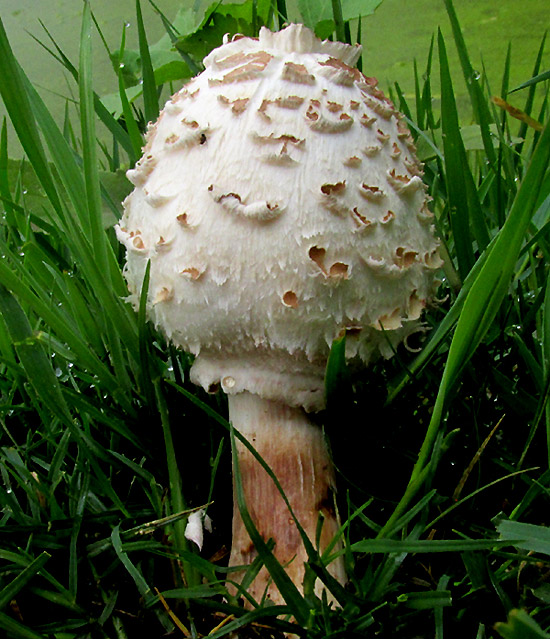
The small pond with its grassy bank existed during the current long-term drought because of the negligence of big landowners at the head of the gully; habitually they let their water pumps keep pumping groundwater long after their irrigated fields are saturated, and the water accumulates here. The above emerging mushroom was one of four in a bed-size area. Notice how brown scales covering the cap are unattached along all their edges, that a ring encircles the stalk immediately below the cap, and the stalk is mostly brown.
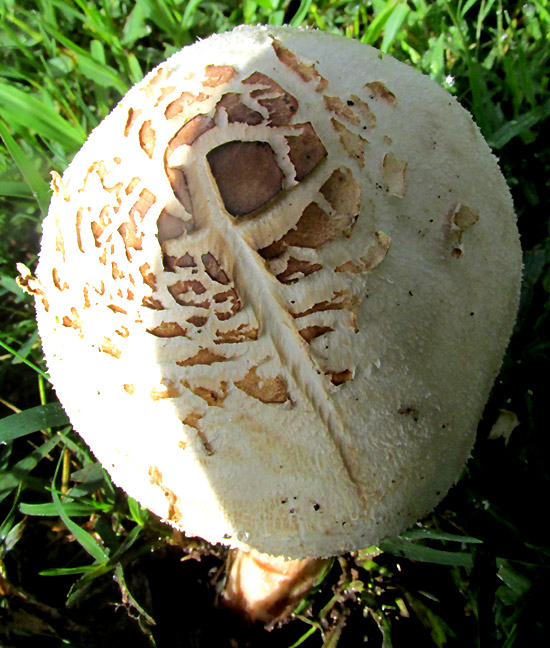
On the above larger, more developed neighbor of the above, the cap has expanded and most of the loose-edged brown scales have come off, but brown patches still cover the cap's center, with the largest patches at the cap's peak.
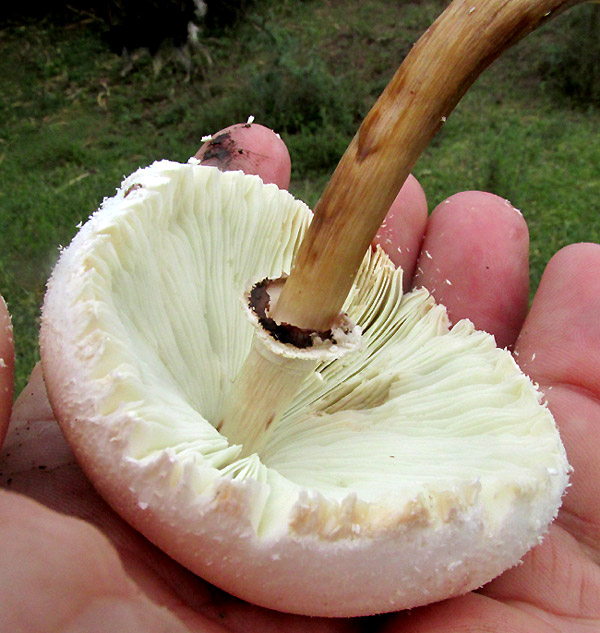
The above mature cap, the largest in the group, was 6cm across (2-1/3inches). The stem was even browner than on the younger mushroom.
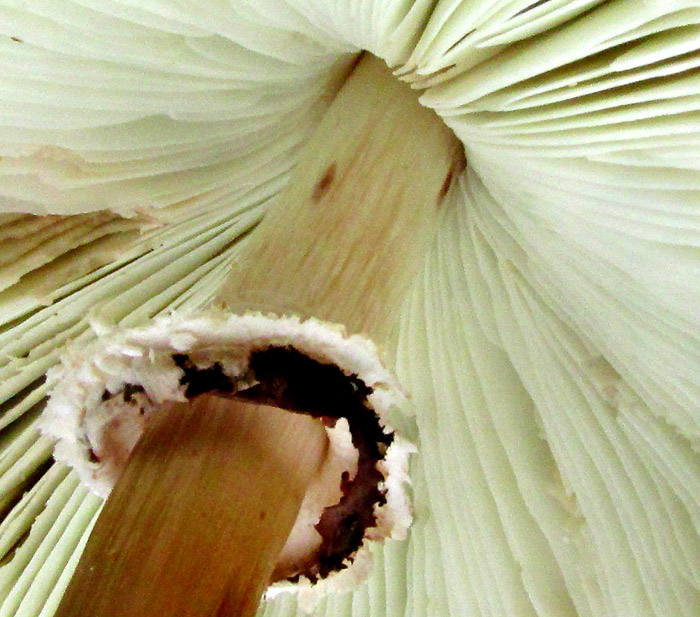
The stalk's ring, sometimes described as double-edged, was curiously blackened on its underside, and was "mobile" -- not physically attached to the stalk. Notice that a kind of notch develops where the gills meet the stalk. On many mushroom species, gills attach to the stalk, and even descend down its sides.
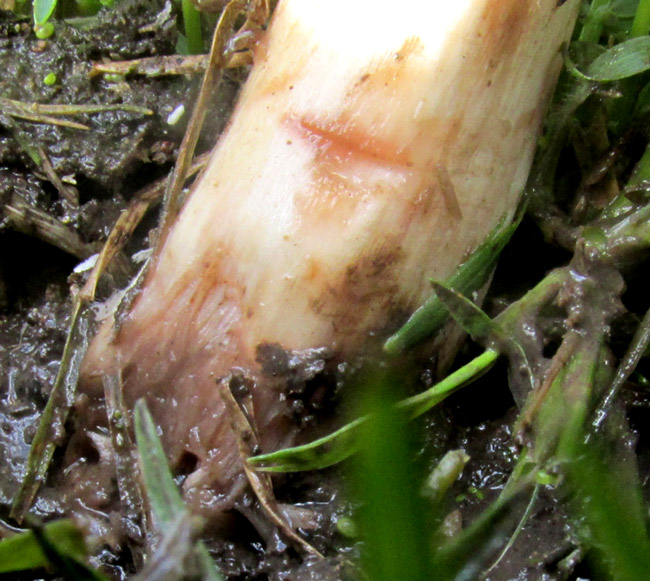
With such a scaly top and a ringed stalk, this could have been one of numerous species of the famously toxic but sometimes highly edible Amanitas, genus Amanita. However, the stalks of Amanitas either arise from a cuplike volva, or toward the stalk base may show scaly remains of the "universal veil," which is the temporary membranous tissue covering the egglike immature mushroom body before it emerges from the soil. Above, the stem is seen with soil scraped away from the base revealing no volva and no hints of a former universal veil. Also, note the horizontal indentation in the stem. That's where a thumbnail was pressed into the flesh to see if a colored bruise resulted. A slight brownness formed, but nothing like the bruises many mushroom species develop.
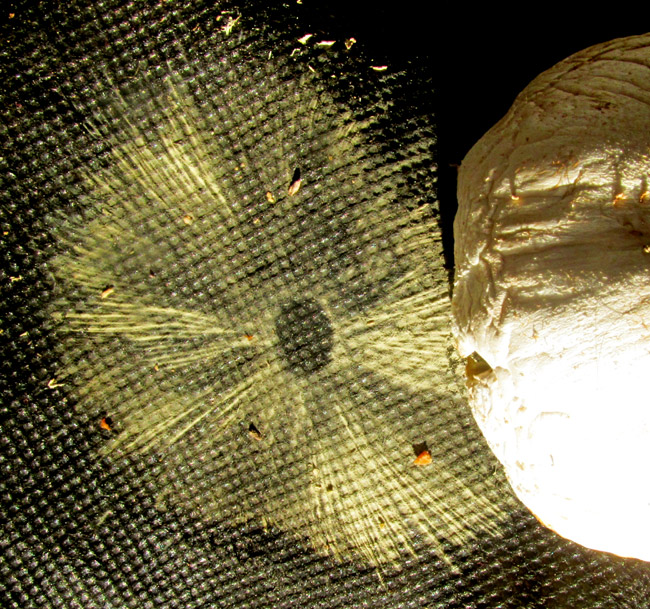
The above spore print turned out a bit tricky looking. The spores seem to be tan colored, but if you notice where the spores concentrate, they're almost white. I think this is a white or nearly white spore print.
Spore print color is important because this mushroom is similar to the Green-spored Parasol, Chlorophyllum molybdites, which famously made me very sick back in 2009. However, on that species' page you can see that the spore print was a very different color, though not green as the common name implies.
In the old days I'd think, "If it looks like an anamita, but isn't, it must be the genus Lepiota." However, I could find no Lepiota looking exactly like our mushrooms. Eventually the genus Macrolepiota came into consideration, the name meaning "big lepiota."
The GBIF occurrences page for Macrolepiota shows that the genus's 40 or so species occur nearly worldwide. On the map, by zooming in on our part of upland central Mexico and clicking on "explore," the resulting list of observations shows that two Macrolepiota species are about equally observed in this region: the species procera and colombiana.
With help from pictures on the Internet showing M. colombiana stalks habitually taller, more slender and darker brown than our mushrooms', and the 1999 study by Ana Esperanza Franco-Molano entitled "A New Species of Macrolepiota from Colombia," which indicatesing that cap scales on M. colombiana aren't as large and unattached at their edges as on our pond-side ones, our mushrooms appear to be MACROLEPIOTA PROCERA. The species is known in English as the Parasol Mushroom, despite that name also being used by numerous other species.
In Europe and eastern North America Macrolepiota procera is a common species in pastures, along grassy trails and roadsides, as well as occasionally in forests. Less commonly it turns up in temperate parts of much of the rest of the world, such as here in upland central Mexico. In Europe, it's highly esteemed as an edible species, but in the US it appears to be less sought, possibly because of frequent toxic reactions caused by eating the similar Green-spored Parasol.
Our pond-side individuals are smaller than most of those illustrated on the Internet; their caps are described as reaching up to 50cm in width (20 inches). I'm guessing that our persisting drought and very low humidity, despite the soil being saturated with runoff pumped groundwater, accounts for the smallness.
However, as Eduardo Fazolina Perez and others state in their 2018 study entitled "Taxonomy and phylogeny of Macrolepiota: two new species from Brazil," "Although Macrolepiota is well known in Europe, China, and Australia, the genus has been scarcely studied in tropical and subtropical areas... " Here in central Mexico we surely have all kinds of taxa not much, or at all, documented in the literature. At least on this page we can file our pictures and information under the name Macrolepiota procera, and hope a researcher someplace may someday be glad to find them.